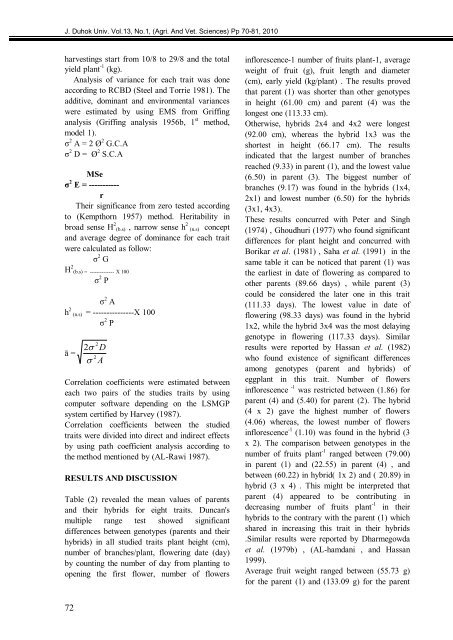The Influence Of Priming Two Cucumber Cultivar Seeds
The Influence Of Priming Two Cucumber Cultivar Seeds
The Influence Of Priming Two Cucumber Cultivar Seeds
You also want an ePaper? Increase the reach of your titles
YUMPU automatically turns print PDFs into web optimized ePapers that Google loves.
J. Duhok Univ. Vol.13, No.1, (Agri. And Vet. Sciences) Pp 70-81, 2010<br />
harvestings start from 10/8 to 29/8 and the total<br />
yield plant -1 (kg).<br />
Analysis of variance for each trait was done<br />
according to RCBD (Steel and Torrie 1981). <strong>The</strong><br />
additive, dominant and environmental variances<br />
were estimated by using EMS from Griffing<br />
analysis (Griffing analysis 1956b, 1 st method,<br />
model 1).<br />
σ 2 A = 2 Ø 2 G.C.A<br />
σ 2 D = Ø 2 S.C.A<br />
MSe<br />
σ 2 E = -----------<br />
r<br />
<strong>The</strong>ir significance from zero tested according<br />
to (Kempthorn 1957) method. Heritability in<br />
broad sense H 2 (b.s) , narrow sense h 2 (n.s) concept<br />
and average degree of dominance for each trait<br />
were calculated as follow:<br />
σ 2 G<br />
H 2 (b.s) = -------------- X 100<br />
σ 2 P<br />
σ 2 A<br />
h 2 (n.s) = ---------------X 100<br />
σ 2 P<br />
ā =<br />
07<br />
2<br />
2<br />
D<br />
2<br />
A<br />
Correlation coefficients were estimated between<br />
each two pairs of the studies traits by using<br />
computer software depending on the LSMGP<br />
system certified by Harvey (1987).<br />
Correlation coefficients between the studied<br />
traits were divided into direct and indirect effects<br />
by using path coefficient analysis according to<br />
the method mentioned by (AL-Rawi 1987).<br />
RESULTS AND DISCUSSION<br />
Table (2) revealed the mean values of parents<br />
and their hybrids for eight traits. Duncan's<br />
multiple range test showed significant<br />
differences between genotypes (parents and their<br />
hybrids) in all studied traits plant height (cm),<br />
number of branches/plant, flowering date (day)<br />
by counting the number of day from planting to<br />
opening the first flower, number of flowers<br />
inflorescence-1 number of fruits plant-1, average<br />
weight of fruit (g), fruit length and diameter<br />
(cm), early yield (kg/plant) . <strong>The</strong> results proved<br />
that parent (1) was shorter than other genotypes<br />
in height (61.00 cm) and parent (4) was the<br />
longest one (113.33 cm).<br />
Otherwise, hybrids 2x4 and 4x2 were longest<br />
(92.00 cm), whereas the hybrid 1x3 was the<br />
shortest in height (66.17 cm). <strong>The</strong> results<br />
indicated that the largest number of branches<br />
reached (9.33) in parent (1), and the lowest value<br />
(6.50) in parent (3). <strong>The</strong> biggest number of<br />
branches (9.17) was found in the hybrids (1x4,<br />
2x1) and lowest number (6.50) for the hybrids<br />
(3x1, 4x3).<br />
<strong>The</strong>se results concurred with Peter and Singh<br />
(1974) , Ghoudhuri (1977) who found significant<br />
differences for plant height and concurred with<br />
Borikar et al. (1981) , Saha et al. (1991) in the<br />
same table it can be noticed that parent (1) was<br />
the earliest in date of flowering as compared to<br />
other parents (89.66 days) , while parent (3)<br />
could be considered the later one in this trait<br />
(111.33 days). <strong>The</strong> lowest value in date of<br />
flowering (98.33 days) was found in the hybrid<br />
1x2, while the hybrid 3x4 was the most delaying<br />
genotype in flowering (117.33 days). Similar<br />
results were reported by Hassan et al. (1982)<br />
who found existence of significant differences<br />
among genotypes (parent and hybrids) of<br />
eggplant in this trait. Number of flowers<br />
inflorescence -1 was restricted between (1.86) for<br />
parent (4) and (5.40) for parent (2). <strong>The</strong> hybrid<br />
(4 x 2) gave the highest number of flowers<br />
(4.06) whereas, the lowest number of flowers<br />
inflorescence -1 (1.10) was found in the hybrid (3<br />
x 2). <strong>The</strong> comparison between genotypes in the<br />
number of fruits plant -1 ranged between (79.00)<br />
in parent (1) and (22.55) in parent (4) , and<br />
between (60.22) in hybrid( 1x 2) and ( 20.89) in<br />
hybrid (3 x 4) . This might be interpreted that<br />
parent (4) appeared to be contributing in<br />
decreasing number of fruits plant -1 in their<br />
hybrids to the contrary with the parent (1) which<br />
shared in increasing this trait in their hybrids<br />
.Similar results were reported by Dharmegowda<br />
et al. (1979b) , (AL-hamdani , and Hassan<br />
1999).<br />
Average fruit weight ranged between (55.73 g)<br />
for the parent (1) and (133.09 g) for the parent



